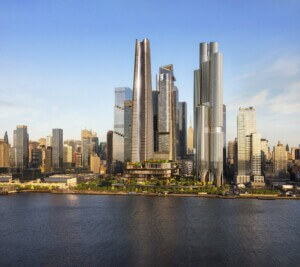UNESCO, the United Nations Educational, Scientific and Cultural Organization, is on the cusp of revoking the English port city of Liverpool’s World Heritage Site status. UNESCO has cited “serious deterioration and irreversible loss of attributes” caused by new waterfront development within the 300-plus-acre, UNESCO-listed heritage zone known as Liverpool Maritime Mercantile City as the reason.
“The inevitable process for the implementation of the Liverpool Waters project and other large scale infrastructure projects in the waterfront and northern dock area of the property and its buffer zone have progressively eroded the integrity of the property and continue to do so as the most recent project proposals and approvals indicate,” elaborated a recent UNESCO report in which the organization made a formal recommendation for delisting.
Composed of six different locations that are home to some of the city’s most iconic landmarks such as the Cunard Building, the Liver Building, St. George’s Hall, the Victoria Tower, and the Albert Dock warehouses, the Liverpool Maritime Mercantile City was inscribed as a World Heritage Site in 2004. Only eight years later, in 2012, it was added to UNESCO’s List of World Heritage in Danger due to a flurry of new construction and proposed developments in the immediate area. The main culprits were the enormous planned Liverpool Waters scheme in Vauxhall and a warmly received $690 million new soccer stadium for Everton FC designed by MEIS architects (the New York-based firm and the club parted ways in June 2020 with technical architect, the London-headquartered Pattern Design, taking the reins) at the largely decrepit Bramley-Moore Dock.
UNESCO said that, if realized, the planned stadium would “have a completely unacceptable major adverse impact on the authenticity, integrity and outstanding universal value of the World Heritage Site.”
As reported earlier this week by the Liverpool Echo, the city’s newly instated mayor, Joanne Anderson, is all in on seeing the project continue despite UNESCO’s recommendation and has stressed the positive economic impact that the future stadium will have on the city.
“Well obviously we’re all disappointed, we don’t want to lose the UNESCO World Heritage Site, but that doesn’t stop us having a world heritage city, does it?” she said. “I think for this particular project (stadium) and how it will impact on Bramley-Moore Dock—I don’t think it’s been open for 40 years—to actually utilise and have a good impact on regeneration in northern Liverpool—I think it’s not a project that we can pull.”
(Mercifully, a council-approved urban zip line attraction that would have sent shrieking tourists sailing hundreds of feet above the historic city center was nixed last August following widespread pushback from Liverpudlians and legal challenges from national conservation groups.)
If the city’s World Heritage Site status is ultimately revoked following the recommendation that came “with deep regret” from the World Heritage Committee, Liverpool would be only the third site to be stripped of the highly revered title since the program was first established in 1978 according to the BBC. The two (former) World Heritage Sites that have been delisted are Germany’s Dresden Elbe Valley and the Arabian Onyx Sanctuary in Oman.
A final decision is expected to be announced later this month regarding the status of Liverpool Maritime Mercantile City.
“I think it is very painful if a site is listed for removal from the World Heritage List,” Dr. Mechtild Rossler, director of the UNESCO World Heritage Centre and the Heritage Division, explained to the BBC, noting that the city has long been aware of its fragile standing on the World Heritage list and that the recommendation for delisting comes not as a warning shot but because the damage has already been done. “We can only propose delisting if you have an analysis that states that the outstanding universal value of the site is lost and that is our analysis,” she said.
Liverpool leaders and residents, understandably, have not taken the recommendation well. Blame is flying fast and furiously in the scandal-embroiled city, with much of it directed at disgraced former Liverpool Mayor Joe Anderson, Liverpool City Council, and UNESCO itself.
Wrote columnist Simon Jenkins in a scathing op-ed for The Guardian:
“Who should be responsible for protecting national—or international—monuments may be moot. But if national governments will not do so, international ones are entitled to a view. Britain often lectures Middle Eastern countries on protecting their monuments. These great cities are for a future world to enjoy. Where local pressure to demolish or despoil a monument is intense, it is customary for national guardianship to operate. In Italy, France and Germany, this guardianship is strong. In Britain it is weak, largely through the political influence of the developer lobby.
Jenrick [local government minister Robert Jenrick] last year humiliated Liverpool by declaring it unfit to govern itself. The least he can now do is rescue it from that humiliation, intervene and negotiate a compromise over its at-risk heritage status. Otherwise, UNESCO should declare him as unfit as he did the city council.”
(Elected in 2012, Joe Anderson, who is not related to current mayor Joanne Anderson, stepped down from his mayorship at the end of last year following his arrest on suspicion of conspiracy to commit bribery and witness intimidation related to city development contracts. He has also since been suspended from the Labour Party.)
In a joint letter published in The Times this past weekend, a number of prominent residents including Mayor Anderson and metro mayor Steve Rotheram, the chief executives of both the Everton and Liverpool football clubs, and several leading clergy members, decried UNESCO’s “unfair” recommendation and urged the organization to reconsider.
The letter reads in part: “Liverpool, like the rest of the world, has had to focus all efforts on dealing with COVID-19 and is currently planning its comeback. Deletion of World Heritage status would be a setback to those plans. And a very unfair one. Liverpool, which is under new political leadership, has made huge strides to invest in – and improve – its World Heritage site. It is in a far superior state than when the status was granted in 2004—and this work demands a fresh appraisal.”
Speaking to The Observer, Lord Michael Heseltine, a signatory of the letter and former Conservative cabinet minister who spearheaded major redevelopment efforts at Albert Dock in the 1980s, elaborated: “[…] the waterfront is so substantial and there are so many important buildings, some of them new. In my view they should certainly not penalise Liverpool for having the courage to move forward. You can’t stop a great city moving forward and you should not try.”
“In any case, I believe the city has always been extremely careful in protecting its heritage as it has introduced change,” he added.
Meanwhile, 200 miles to the south on Salisbury Plain, Stonehenge, undoubtedly the most famous of Britain’s World Heritage-inscribed sites, is at risk of joining Liverpool and 52 other sites on UNESCO’s List of Heritage in Danger. That’s due to government-approved relocation of a perpetually gridlocked highway into a massive, $2.2 billion tunnel beneath the Neolithic rock formation.











